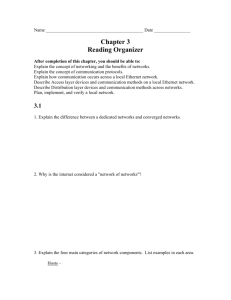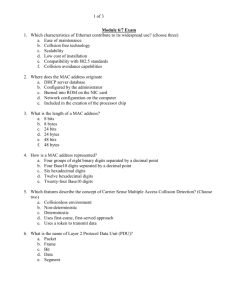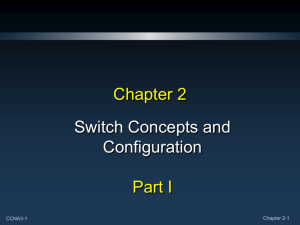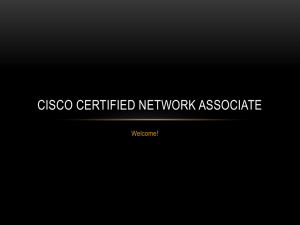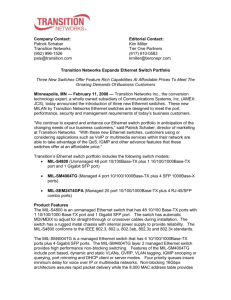Chapter 2 Switch Concepts and Configuration Part I
advertisement
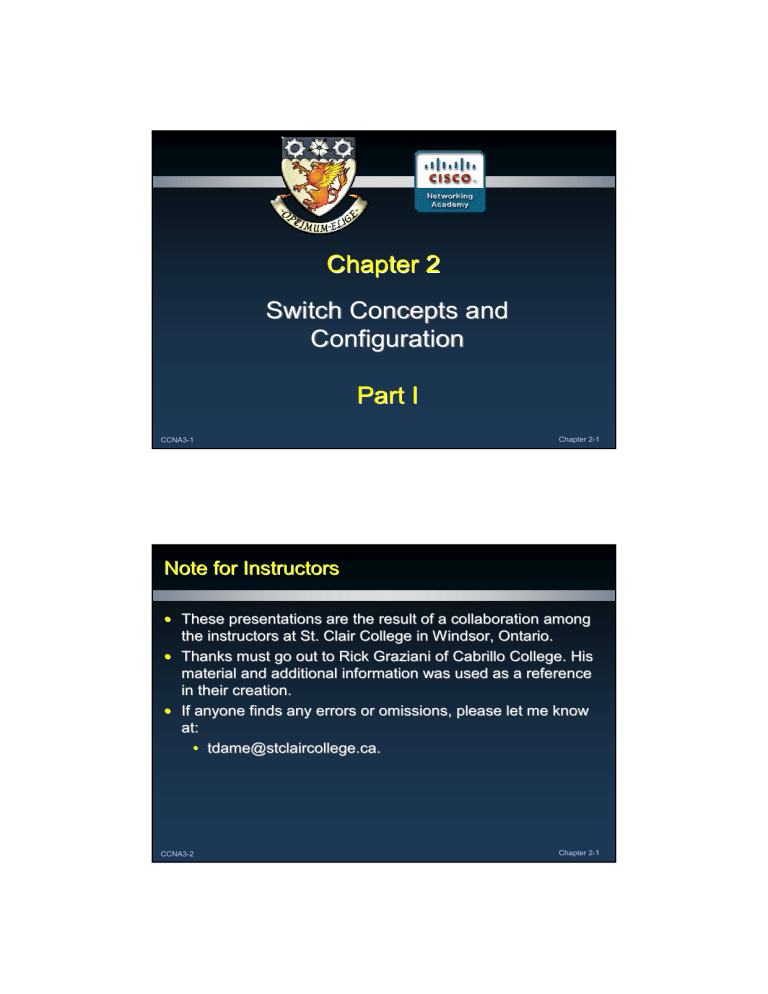
Chapter 2
Switch Concepts and
Configuration
Part I
CCNA3-1
Chapter 2-1
Note for Instructors
• These presentations are the result of a collaboration among
the instructors at St. Clair College in Windsor, Ontario.
• Thanks must go out to Rick Graziani of Cabrillo College. His
material and additional information was used as a reference
in their creation.
• If anyone finds any errors or omissions, please let me know
at:
• tdame@stclaircollege.ca.
CCNA3-2
Chapter 2-1
Switch Concepts and Configuration
Key Elements of
Ethernet/802.3 LANs
Chapter 2-1
CCNA3-3
CSMA/CD
CCNA3-4
Chapter 2-1
Ethernet Communications
Chapter 2-1
CCNA3-5
Ethernet Communications
• Ethernet Frame: Minimum 64 bytes, Maximum 1518 bytes
•
•
•
•
•
•
Preamble/SOFD: Synchronize to medium.
Destination Address: MAC Address of destination device.
Source Address: MAC address of source device.
Length/Type: Length of frame or protocol type code.
Data: Encapsulated data from OSI Layers 7 to 3.
FCS: Frame Check Sequence.
CCNA3-6
Chapter 2-1
Ethernet Communications
• MAC Address: 12 hexadecimal digits
•
•
•
•
Broadcast: Indicates a broadcast or multicast frame.
Local: indicates whether the address can be modified locally.
OUI Number: Manufacturer of the NIC.
Vendor Number: Unique, vendor assigned number.
Chapter 2-1
CCNA3-7
Ethernet Communications
CCNA3-8
Chapter 2-1
Ethernet Communications
• Switch Port Settings:
• AUTO:
• AutoAuto-negotiation of duplex mode. The two ports
communicate to determine the best mode.
• Default for FastEthernet and 10/100/1000 ports.
• FULL:
• FullFull-duplex mode.
• Default for 100BASE100BASE-FX ports.
• HALF:
• HalfHalf-duplex mode.
Configuration commands later in the chapter.
Chapter 2-1
CCNA3-9
Ethernet Communications
• Switch Port Settings:
• AUTO:
• AutoAuto-negotiation of duplex mode. The two ports
communicate to determine the best mode.
• AutoAuto-negotiation can produce unpredictable results.
• If autoauto-negotiation fails because the attached device
does not support it, the Catalyst switch defaults the
switch port to halfhalf-duplex mode.
mode.
• HalfHalf-duplex on one end and fullfull-duplex on the other
causes late collision errors at the halfhalf-duplex end.
• To avoid this, manually set the duplex parameters of
the switch to match the attached device.
CCNA3-10
Chapter 2-1
Ethernet Communications
• Switch Port Settings:
• AutoAuto-MDIX feature:
• In the past, either a crosscross-over or a straightstraight-through
cable was required depending on the type of device
that was being connected to the switch.
• Instead, the mdix auto interface configuration
command enables the automatic mediummedium-dependent
interface crossover (auto(auto-MDIX) feature.
• With this feature enabled, the switch detects the
interface required for copper media and configures the
interface accordingly.
Configuration commands later in the chapter.
Chapter 2-1
CCNA3-11
Switch MAC Address Table
• Switches use MAC addresses to direct network traffic to the
appropriate port.
• A switch builds a MAC address table by learning the MAC
addresses of each device connected to each of its ports.
• Once the MAC address has been added to the table, the
switch uses the table entry to forward traffic to that node.
• If a destination address is not in the table, the switch
forwards the frame out all ports except the receiving port.
• When the destination responds, the MAC address is
added to the table.
• If the port is connected to another switch or a hub,
multiple MAC addresses will be recorded in the table.
CCNA3-12
Chapter 2-1
Switch MAC Address Table
• Example Step 1:
• The switch receives a broadcast frame from PC 1
on Port 1.
Chapter 2-1
CCNA3-13
Switch MAC Address Table
• Example Step 2:
• The switch enters the source MAC address and the
switch port that received the frame into the address table.
CCNA3-14
Chapter 2-1
Switch MAC Address Table
• Example Step 3:
• Because the destination address is a broadcast, the
switch floods the frame to all ports, except the port on
which it received the frame.
frame.
Chapter 2-1
CCNA3-15
Switch MAC Address Table
• Example Step 4:
• The destination device replies to the broadcast with a
unicast frame addressed to PC 1.
1.
CCNA3-16
Chapter 2-1
Switch MAC Address Table
• Example Step 5:
• The switch enters the source MAC address of PC 2 and
the port number of the switch port that received the frame
into the address table.
Chapter 2-1
CCNA3-17
Switch MAC Address Table
• Example Step 6:
• The switch can now forward frames between source and
destination devices because it has entries in the address
table that identify the associated ports.
CCNA3-18
Chapter 2-1
Design Considerations – Ethernet/802.3
• Bandwidth and Throughput:
• A major disadvantage of Ethernet is collisions.
• When two hosts transmit frames simultaneously, the
collision results in the transmitted frames being
corrupted or destroyed.
• The sending hosts stop sending based on the
Ethernet 802.3 rules of CSMA/CD.
• It is important to understand that when stating the
bandwidth of the Ethernet network is 10 Mb/s, full
bandwidth for transmission is available only after any
collisions have been resolved.
resolved.
Chapter 2-1
CCNA3-19
Design Considerations – Ethernet/802.3
• Bandwidth and Throughput:
• A major disadvantage of Ethernet is collisions.
• A hub offers no mechanisms to either eliminate or
reduce collisions and the available bandwidth that any
one node has to transmit is correspondingly reduced.
• As a result, the number of nodes sharing the Ethernet
network will have effect on the throughput.
throughput.
CCNA3-20
Chapter 2-1
Design Considerations – Ethernet/802.3
• Collision Domains:
• To reduce the number of nodes on a given network
segment, you can create separate physical network
segments called collision domains.
domains.
• The network area where frames originate and collide
is called the collision domain.
domain.
• All shared media environments, such as those
created by using hubs are collision domains.
• When a host is connected to a switch port,
port, the
switch creates a dedicated connection. This
connection is an individual collision domain.
domain.
CCNA3-21
Chapter 2-1
Design Considerations – Ethernet/802.3
• Microsegment:
• When two connected hosts want
to communicate with each other,
the switch uses the switching
table to establish a connection
between the ports.
• The circuit is maintained until the session is terminated.
• The microsegment behaves as if the network has only
two hosts, providing maximum available bandwidth to
both hosts.
• Switches reduce collisions and improve bandwidth use
on network segments because they provide dedicated
bandwidth to each network segment.
segment.
CCNA3-22
Chapter 2-1
Design Considerations – Ethernet/802.3
• Broadcast Domains:
• Although switches filter most frames based on MAC
Interconnecting
addresses, they do not filter broadcast
frames.
frames.
switches
extends
the
• Why?
broadcast domain.
• Because a switch runs at Layer 2 and cannot learn
the MAC address FFFFFFFFFFFF.
FFFFFFFFFFFF.
• A collection of interconnected switches forms a broadcast
domain.
• Only Layer 3 devices or a VLAN form separate broadcast
domains.
CCNA3-23
Chapter 2-1
Design Considerations – Ethernet/802.3
• Network Latency:
• Latency is the time a frame or a packet takes to travel
from the source to the final destination.
CCNA3-24
Chapter 2-1
Design Considerations – Ethernet/802.3
• Network Congestion:
• The primary reason for segmenting a LAN into smaller
parts is to isolate traffic and to achieve better use of
bandwidth per user.
• Without segmentation, a LAN quickly becomes clogged
with traffic and collisions.
• Most common causes:
• Increasingly powerful computer and network
technologies.
• Increasing volume of network traffic.
• HighHigh-bandwidth applications.
Chapter 2-1
CCNA3-25
Design Considerations – Ethernet/802.3
• LAN Segmentation:
• LANs are segmented into a number of smaller collision
and broadcast domains using routers and switches.
CCNA3-26
Hub
Chapter 2-1
Design Considerations – Ethernet/802.3
• LAN Segmentation:
• LANs are segmented into a number of smaller collision
and broadcast domains using routers and switches.
JAM
JAM
JAM
CCNA3-27
JAM
JAM
JAM
JAM
JAM
JAM
JAM
JAM
JAM
JAM
JAM
Hub
JAM
JAM
Chapter 2-1
Design Considerations – Ethernet/802.3
• LAN Segmentation:
• LANs are segmented into a number of smaller collision
and broadcast domains using routers and switches.
Collision
Domains
Broadcast Domain
CCNA3-28
Switch
Chapter 2-1
Design Considerations – Ethernet/802.3
• LAN Segmentation:
• LANs are segmented into a number of smaller collision
and broadcast domains using routers and switches.
Collision
Broadcast
Domains
Domains
CCNA3-29
Router
Chapter 2-1
Design Considerations – Ethernet/802.3
• LAN Segmentation:
• LANs are segmented into a number of smaller collision
and broadcast domains using routers and switches.
CCNA3-30
Chapter 2-1
LAN Design Considerations
• There are two primary considerations when designing a LAN:
• Controlling network latency
• Removing bottlenecks
Chapter 2-1
CCNA3-31
LAN Design Considerations
• Controlling Network Latency:
• Consider the latency caused by each device on the
network.
• Switches at Layer 2 can introduce latency on a
network when oversubscribed on a busy network.
• If a core level switch has to support 48 ports, each
one capable of running at 1000 Mb/s full duplex,
the switch should support around 96 Gb/s internal
throughput if it is to maintain full wire speed across
all ports simultaneously.
CCNA3-32
Chapter 2-1
LAN Design Considerations
• Controlling Network Latency:
• Consider the latency caused by each device on the
network.
• The use of higher layer devices can also increase
latency on a network.
• When a Layer 3 device, such as a router, needs to
examine the Layer 3 addressing information
contained within the frame, it must read further into
the frame than a Layer 2 device, which creates a
longer processing time.
Chapter 2-1
CCNA3-33
LAN Design Considerations
• Removing Network Bottlenecks:
• Each workstation and the server are connected at
1000Mbps.
Add
If all4 workstations
additional
1000Mbps
access theNICs
server
to at
server.time.
the same
CCNA3-34
Chapter 2-1
Switch Concepts and Configuration
Forwarding Frames
Using a Switch
StoreStore-andand-forward
Store-and-forward
CutCut-through
Cut-through
Symmetric
Asymmetric
FastFast-forward
Fast-forward
FragmentFragment-free
Fragment-free
CCNA3-35
Memory Buffering
Layer 2 and Layer 3 Switching
Chapter 2-1
Switch Forwarding Methods
• Methods switches use to forward Ethernet frames.
• StoreStore-andand-forward.
• CutCut-through:
• FastFast-forward switching.
• FragmentFragment-free switching.
CCNA3-36
Chapter 2-1
Switch Forwarding Methods
• StoreStore-and forward:
• Receives the entire frame.
• Computes the CRC and checks the frame length.
• If valid, checks the switch table for the destination
CRC
address and forwards the frame.Destinatio
Frame
n
is in
• If invalid, the frame is dropped. 123896745
found
=
Destination Source Data FCS
Good
Switching
123896745
Table
Chapter 2-1
CCNA3-37
Switch Forwarding Methods
• StoreStore-and forward:
• Receives the entire frame.
• Computes the CRC and checks the frame length.
• If valid, checks the switch table for the destination
address and forwards the frame.
• If invalid, the frame is dropped.
• StoreStore-and forward is the only method used on current
Cisco Catalyst switches.
• Needed for QoS on converged networks.
CCNA3-38
Chapter 2-1
Switch Forwarding Methods
• CutCut-through:
• Forwards a frame before it is entirely received.
• At a minimum, it must read the destination and source
MAC addresses.
• Faster than storestore-andand-forward.
• No error checking.
• Any corrupt frames are still forwarded and consume
network bandwidth.
Chapter 2-1
CCNA3-39
Switch Forwarding Methods
• CutCut-through – FastFast-forward:
• Typical method of cutcut-through.
• Forwards a frame immediately after it reads and finds the
destination address.
• CutCut-through – FragmentFragment-free:
• Stores the first 64 bytes of the frame before forwarding.
• The first 64 bytes of the frame is where most network
errors and collisions occur.
• Checks for a collision before forwarding the frame.
• Some switches are configured to use cutcut-through on each
port until a user defined error threshold is reached. At that
time, they change to storestore-and forward.
CCNA3-40
Chapter 2-1
Symmetric and Asymmetric Switching
• Symmetric:
• All ports are of the same bandwidth.
• Optimized for a reasonably distributed traffic load.
• For example, a peerpeer-toto-peer network.
Chapter 2-1
CCNA3-41
Symmetric and Asymmetric Switching
• Asymmetric:
• Provides switched connections between ports
of unlike bandwidth.
• For example, more bandwidth can be assigned to a
server to prevent bottlenecks.
CCNA3-42
Chapter 2-1
Memory Buffering
• A switch analyzes some or all of a packet before it forwards it
to the destination host based on the forwarding method.
• It stores the packet for the brief time in a memory buffer.
buffer.
• Built into the hardware
• Two types:
• Port based.
• Shared.
Chapter 2-1
CCNA3-43
Memory Buffering
• Port Based:
• Frames are stored in queues that are linked to specific
incoming and outgoing ports.
• A frame is transmitted to the outgoing port only when all
the frames ahead of it in the queue have been
successfully transmitted.
• It is possible for a single frame to delay the transmission
of all the frames in memory because of a busy destination
port.
CCNA3-44
Chapter 2-1
Memory Buffering
• Shared:
• Deposits all frames into a common memory buffer that all
the ports on the switch share.
• The amount of buffer memory required by a port is
dynamically allocated.
• The frames in the buffer are linked dynamically to the
destination port.
• Allows the packet to be received on one port and then
transmitted on another port, without moving it to a
different queue.
Chapter 2-1
CCNA3-45
Layer 2 and Layer 3 Switching
• Layer 2 Switching:
• Performs switching and filtering based only on the OSI
Data Link layer (Layer 2) MAC address.
• Completely transparent to network protocols and user
applications.
• Remember that a Layer 2 switch builds a MAC address
table that it uses to make forwarding decisions.
Cisco Catalyst
2960 Series
CCNA3-46
Chapter 2-1
Layer 2 and Layer 3 Switching
• Layer 3 Switching:
• Functions similarly to a Layer 2 switch but instead of
using only the Layer 2 MAC address a Layer 3 switch can
also use IP address information.
• A Layer 3 switch can also learn which IP addresses are
associated with its interfaces.
• This allows the Layer 3 switch to direct traffic throughout
the network based on IP address information.
Cisco Catalyst
3560 Series
Chapter 2-1
CCNA3-47
Layer 2 and Layer 3 Switching
• Layer 3 Switching:
• However, Layer 3 switches do not completely replace the
need for routers on a network.
• Routers perform additional Layer 3 services that Layer
3 switches are not capable of performing.
CCNA3-48
Chapter 2-1
Switch Concepts and Configuration
Switch Management Configuration
CCNA3-49
Chapter 2-1
Navigating Command-Line Interface Modes
• CLI itself is basically the same as a router:
• Access modes with a password.
• Help Facility and Command History
• Configure console and telnet access.
• Commands to configure options for each interface.
• Commands to verify the status of the switch.
• The difference is the functions to be configured:
• Commands to create and control VLANs (Chapter 3)
• Configure a default gateway.
• Manage the MAC Address table.
• Switch security.
CCNA3-50
Chapter 2-1
Navigating Command-Line Interface Modes
• Access Levels:
• User EXEC.
• Privileged EXEC.
CCNA3-51
Chapter 2-1
Navigating Command-Line Interface Modes
• Configuration Modes:
• Global Configuration Mode.
• Interface Configuration Mode (and more…
more….)
CCNA3-52
Chapter 2-1
Navigating Command-Line Interface Modes
• GUIGUI-Based Alternatives to the CLI:
• Cisco Network Assistant.
• Configure and manage groups of switches or
standalone switches.
• Free from www.cisco.com with a Cisco ID and
Password.
CCNA3-53
Chapter 2-1
Navigating Command-Line Interface Modes
• GUIGUI-Based Alternatives to the CLI:
• Cisco View.
• Displays a physical view of the switch that you can
use to set configuration parameters.
• View switch status and performance information.
• Purchased separately.
• Can be a standalone application or part of a Simple
Network Management Protocol (SNMP) platform.
CCNA3-54
Chapter 2-1
Navigating Command-Line Interface Modes
• GUIGUI-Based Alternatives to the CLI:
• Cisco Device Manager.
• WebWeb-based software that is stored in the switch
memory.
• Configure and manage switches.
• Access from anywhere in your network through a web
browser.
CCNA3-55
Chapter 2-1
Navigating Command-Line Interface Modes
• GUIGUI-Based Alternatives to the CLI:
• SNMP Network Management.
• You can manage switches from a SNMPSNMP-compatible
management station, such as HP OpenView.
• The switch is able to provide comprehensive
management information.
• SNMP network management is more common in large
enterprise networks.
CCNA3-56
Chapter 2-1
Using the Help Facility
• Word / Command line syntax Help:
Chapter 2-1
CCNA3-57
Using the Help Facility
• Console Error Messages:
CCNA3-58
Chapter 2-1
Switch Boot Sequence
• Switch loads the Boot Loader program.
• Small program stored in NVRAM.
• CPU Initialization.
• POST.
• Initializes flash memory.
• Loads a default OS image into memory and boots the
switch.
• The OS then initializes the interfaces using the Cisco IOS
commands found in the operating system configuration
file config.text,
config.text, stored in the switch flash memory.
Chapter 2-1
CCNA3-59
Prepare to Configure the Switch
• A PC connected to the console port.
• A terminal emulator application (e.g.. HyperTerminal) is
running and configured correctly.
• Attach the power cord to the switch.
• Some Catalyst switches, including the 2950 and 2960
series switches do not have a power button.
button.
CCNA3-60
Chapter 2-1
Prepare to Configure the Switch
• Observe the Boot Sequence.
• When the switch is powered on, the POST begins.
• During POST, the LEDs blink while a series of tests
determine that the switch is functioning properly.
• Successful: the SYST LED rapidly blinks green.
green.
• Fails: the SYST LED turns amber.
amber.
Chapter 2-1
CCNA3-61
Prepare to Configure the Switch
• Observe the Boot Sequence.
• The Port Status LEDs turn amber for about 30 seconds
as the switch discovers the network topology and
searches for loops.
• If the Port Status LEDs turn green,
green, the switch has
established a link between the port and a target, such as
a computer.
CCNA3-62
Chapter 2-1
Basic Switch Configuration
• Key Configuration Sequences:
• Switch Management Interface:
• To manage a switch remotely using TCP/IP, you need
to assign the switch an IP address.
• An access layer switch is much like a PC in that you
need to configure an IP address, a subnet mask, and
a default gateway.
gateway.
• Duplex and Speed of active interfaces:
• Usually the default but can be modified.
• Support for HTTP access.
• We will restrict ourselves to the CLI.
• MAC address table management.
Chapter 2-1
CCNA3-63
Basic Switch Configuration
• Switch Management Interface:
CCNA3-64
Chapter 2-1
Basic Switch Configuration
• Switch Management Interface:
• Note that a Layer 2 switch, such as the Cisco Catalyst
2960, only permits a single VLAN interface to be active at
a time.
time.
• This means that the Layer 3 interface (interface VLAN 99)
is active,
active, but the Layer 3 interface (interface VLAN 1) is
not active.
active.
Chapter 2-1
CCNA3-65
Basic Switch Configuration
• Configure Default Gateway:
• You need to configure the switch so that it can forward IP
packets to distant networks.
• Remember, the switch is treated like a host in this setup.
• This is only used to forward switch management traffic.
• It has nothing to do with any of the regular user data
traffic.
• Why does it have to be forwarded?
• You can make a Telnet or SSH connection to a switch
from another subnet to perform maintenance or
troubleshoot.
CCNA3-66
Chapter 2-1
Basic Switch Configuration
• Verify Configuration:
Chapter 2-1
CCNA3-67
Basic Switch Configuration
• Configure Duplex and Speed:
• You can use the duplex interface configuration command
to specify the duplex mode of operation for switch ports.
• You can manually set the duplex mode and speed of
switch ports to avoid interinter-vendor issues with
autonegotiation.
CCNA3-68
Chapter 2-1
Basic Switch Configuration
• Configure HTTP Access:
• Modern Cisco switches have a number of webweb-based
configuration tools that require that the switch is
configured as an HTTP server.
• These applications include:
• Cisco web browser user interface.
• Cisco Router and Security Device Manager (SDM).
• IP Phone and Cisco IOS Telephony Service
applications.
• Be aware that these services are not necessarily
activated in a configuration. The availability of this option
does not mean that you do not need to know how to use
the CLI commands.
Chapter 2-1
CCNA3-69
Basic Switch Configuration
• MAC Address Table Management:
• Switches use MAC address tables to determine how to
forward traffic between ports.
• These MAC tables include dynamic and static addresses.
CCNA3-70
Chapter 2-1
Basic Switch Configuration
• Dynamic MAC Addresses:
• The switch provides dynamic addressing by learning the
source MAC address of each frame that it receives on
each port.
• It then adds the source MAC address and its associated
port number to the MAC address table.
• As devices are added or removed from the network, the
switch updates the MAC address table.
• It adds new entries and ages out those that are
currently not in use.
Chapter 2-1
CCNA3-71
Basic Switch Configuration
• Static MAC Addresses:
• A network administrator can specifically assign static
MAC addresses to certain ports.
• Static addresses are not aged out.
out.
• The switch always knows which port to send out traffic
destined for that specific MAC address.
• To create a static mapping in the MAC address table, use
the command:
macmac-addressaddress-table static <MAC address>
vlan {1{1-4096, ALL}
interface interfaceinterface-id
• To remove it, use the ‘no’
no’ form of the command.
CCNA3-72
Chapter 2-1
Verifying Switch Configuration
• Using the show commands:
Chapter 2-1
CCNA3-73
Basic Switch Management
• Backing up and Restoring Switch Configuration Files:
• Backup to the flash drive.
CCNA3-74
Chapter 2-1
Basic Switch Management
• Backing up and Restoring Switch Configuration Files:
• Restore from the flash drive.
Chapter 2-1
CCNA3-75
Basic Switch Management
• Backing up and Restoring Switch Configuration Files:
• Backup to a TFTP server.
• Make sure that the TFTP server is running.
• Login to the switch.
• Upload the configuration to the TFTP server.
S1#copy system:runningsystem:running-config tftp://172.16.2.155/S1Rconfig.txt
or…
or….S1#copy run tftp
or….S1#copy
CCNA3-76
Chapter 2-1
Basic Switch Management
• Backing up and Restoring Switch Configuration Files:
• Restore from a TFTP server.
• Make sure that the TFTP server is running.
• Login to the switch.
• download the configuration to the TFTP server.
S1#copy tftp://172.16.2.155/S1Rconfig.txt system:runningsystem:running-config
S1#copy runningrunning-config startupstartup-config
S1#reload
CCNA3-77
or…
or….S1#copy tftp run
or….S1#copy
S1#copy run
start
S1#reload
Chapter 2-1
Basic Switch Management
• Backing up and Restoring Switch Configuration Files:
• Clearing configuration files.
• Deleting files from the flash drive.
• delete flash:filename
CCNA3-78
Chapter 2-1

